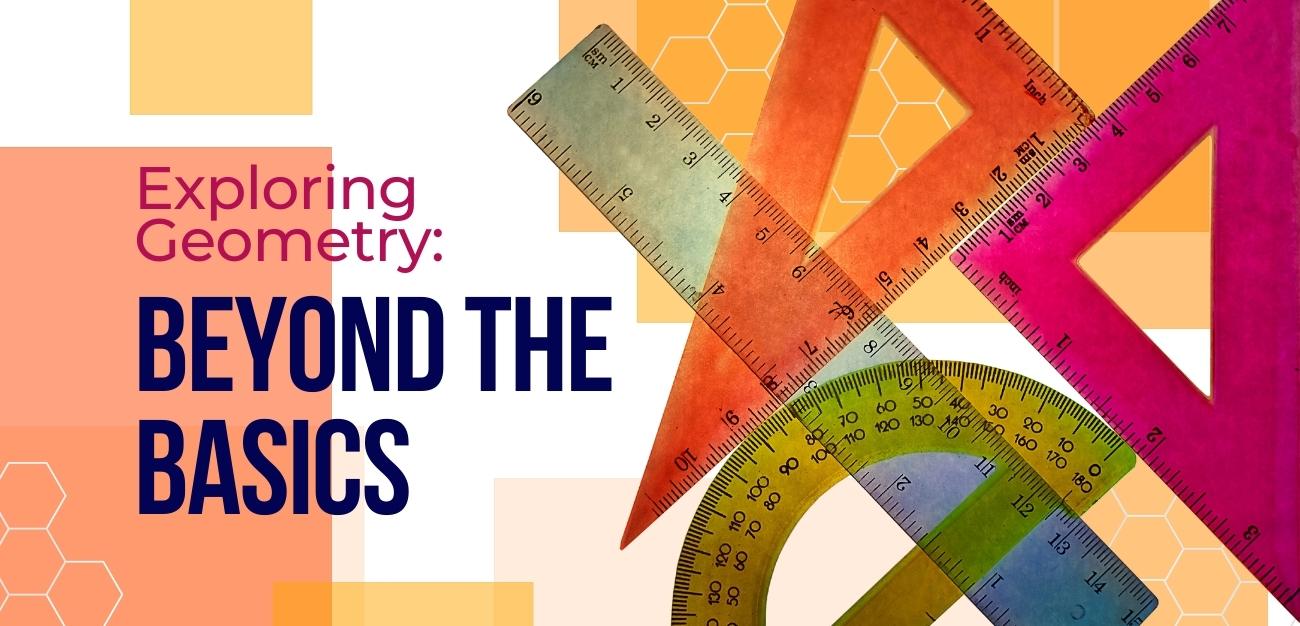If you’ve been finding it a struggle to help your child with their geometry homework, this blog post is your perfect companion. Geometry, as you may recall from your own school days, often feels foreign and perplexing to untrained minds. However, with the right methods and patience, explaining it to your kids can transform into an enjoyable and enlightening experience.
So, let’s venture beyond the basics, leap over the hurdles, and discover the fascinating world of shapes, angles, lines, and points together. In this blog post, we’ll be journeying through the seemingly complex realms of geometry and breaking them down into bite-sized nuggets that you can use to help your child grasp this essential field of mathematics.
Here is a sneak-peak of what we’ll cover:
- Understanding the fundamentals: Points, Lines, and Angles
- Unfolding the world of shapes: From simple to complex
- Learning the language of geometry: Terms and definitions
- Geometry in the real world: Applying the knowledge
Let’s plunge right in and make geometry an interesting and comprehensible subject for your children.
Shapes: The Building Blocks Of Geometry
Think of geometry as a city, and shapes as the buildings that make up that city. Yes, shapes – they’re absolutely everywhere, and they’re the perfect place to start when explaining geometry to your children. They form the base of many geometric principles and understanding them well can provide a substantial headstart.
There are two fundamental types of shapes to understand first – 2D (Two-Dimensional) and 3D (Three-Dimensional) shapes. So what’s the difference?
A 2D shape has only two dimensions – length and width, like the screen display of your phone. A square or a circle is a 2D shape. A 3D shape, on the other hand, has an extra dimension – depth, like an ice cream cone or a box of cereal.
So, how can you teach your children to identify these shapes? Here are some fun and interactive ways:
- The ‘I Spy’ Game: You can play the classic ‘I Spy’ game but with a geometrical spin. Spy something that resembles a particular shape and let your child guess. Eg. “I spy with my little eye, something that is round.”
- Shape Hunt: Arrange a treasure hunt where the clues are based on shapes. This will help in the practical identification of shapes. For example, “Look under the round plate.”
- Shape Crafts: Making crafts using shapes will not only teach them geometry but also improve their motor skills. Provide them with coloured paper cut-outs and ask them to create a collage or a 3D model.
With shapes under our belt, we can move onto more complex aspects of geometry. But always remember, the aim is not just to memorize but to understand. So take your time, rewind if necessary, and have fun while you’re at it!
Exploring 2D Shapes: Lines, Angles, And Polygons
Stepping up a bit from the world of simple shapes, we delve into the complex and intriguing realm of two-dimensional (2D) shapes. These forms, including lines, angles, and polygons, are integral to the foundation of geometry.
Lines are more than just straight marks on paper. In geometry, a line is a straight one-dimensional figure that extends indefinitely in both directions. So, how can you explain this to your child? Try this: imagine a never-ending road that goes on in both directions. That, right there, is what a line is in geometry.
- Infinite Line: A never-ending straight path is called an infinite line.
- Line Segment: A portion of a line that has two fixed ends. Think of it as a piece of the ‘infinite line road’ that has a beginning and an end.
- Ray: A line segment that keeps going on forever in one direction. So imagine that our road has a starting point but never has an end point.
Next up, we encounter angles. Think of an angle as the space or ‘bend’ created when two lines meet at a point. Angles are measured in degrees.
| Angle Type | Description |
| Acute | An angle less than 90 degrees |
| Right | An angle that measures exactly 90 degrees |
| Obtuse | An angle that measures more than 90 degrees but less than 180 degrees |
Lastly, we focus on polygons, which are 2D shapes with straight sides. Here’s a quick rundown:
- Triangle: a shape with 3 sides and 3 angles.
- Rectangle: a four-sided polygon with opposite sides of equal length and four right angles.
- Pentagon: a polygon with 5 sides and 5 angles.
- Hexagon: a polygon with 6 sides and 6 angles, and so on.
While these concepts may seem simple to adults, keep in mind that for children, they are a gateway into a complex new world. Practice these basic geometry concepts with your kids, and reinforce them with drawings, physical objects around the house, or online games to make learning fun and engaging!
Discovering 3D Shapes: Solids And Their Properties
As we dive deeper into the world of geometry, we encounter three-dimensional shapes or solids. These are geometric figures that have length, width, and height. Just like two-dimensional shapes, solids have properties that can be recognized and used to solve problems. But unlike the flat figures, these shapes are tactile and can be held, stacked, and even nested.
Let’s walk through each solid and their unique properties:
- Cubes: Perhaps one of the easiest 3D solids to recognize, a cube has all sides equal and every angle measures a perfect 90 degrees.
- Spheres: These are perfectly round shapes, think of a basketball. Spheres have no edges or vertices.
- Cylinders: Imagine a soup can. A cylinder has two parallel, congruent circles (bases) connected by a curved surface.
- Cones: A real life example is an ice cream cone. A cone has one circular base that narrows smoothly to a point called the vertex.
- Pyramids: Like the pyramids in Egypt, they have a polygon base and triangular sides that meet at a point called the vertex.
Manipulating these shapes and exploring their properties can be a fun and enlightening activity. You can use various household objects to represent these solids and help your child understand them better. For instance, dice can represent a cube, a ball can represent a sphere, a can of soup can represent a cylinder, etc.
Geometry can be found all around us, in the built environment, in nature, and even in outer space. Encouraging your child to recognize these shapes in their surroundings will help reinforce the concepts learned and prove that geometry, far from being an abstract subject, is part of our everyday life.
Remember: Understanding and mastering the basics of geometry can open up a world of critical and spatial thinking for your child. With a strong foundation, they’ll be ready for the more complex concepts that come with higher-level mathematics.
Mastering Geometry Vocabulary: Key Terms For Kids
Just like every other field of study, geometry has its own lingo. The vocabulary can be a bit overwhelming at first, but don’t worry. We’ve got you covered. Let’s take a look at some of the key terms your child will encounter in their geometry studies.
Point:
A point refers to an exact location in space. It’s named with a single capital letter. On paper, it’s represented by a small dot.
Line:
A line is an endless sequence of points extending in two directions. We represent it with a straight line that has arrows on both ends. A line is typically named by two points on it, such as ‘Line AB’.
Plane:
In geometry, a plane is a flat, two-dimensional surface that extends infinitely in all directions.
Angle:
An angle is formed when two lines meet at a point. There are several types of angles your kids will learn about: acute (less than 90 degrees), right (90 degrees), obtuse (greater than 90 but less than 180 degrees), and straight (180 degrees).
Polygon:
A polygon is a 2D shape with three or more straight sides. Some examples include triangles (3 sides), quadrilaterals (4 sides), pentagons (5 sides), and so on.
Circle:
A circle is a 2D shape where all points are the same distance from a fixed center point. Key terms include radius (the distance from the center to any point on the circle) and diameter (a straight line passing through the center, connecting two points on the circle).
There are, of course, a multitude of other terms in geometry, each with its own purpose and meaning. As your child progresses in their studies, they will become more familiar with these terms and their applications. Remember, the goal is to make learning engaging and fun, not stressful or overwhelming.
Geometry In Everyday Life: Real-World Applications
Geometry isn’t just an abstract concept confined to textbooks; it’s everywhere! To help your children see the value in studying geometry, it’s essential to bring out practical and fascinating real-world applications. Let’s explore some of these examples!
Architecture: Just take a look at any building around you – a house, school, store, or a monumental skyscraper. Geometry helps in designing these constructions. Squares and rectangles influencing room layouts, triangular roofs, cylindrical pillars, semi-circular arches – these are all examples of geometry in the world of architecture.
Art: Many artists embrace the principles of geometry to create pleasing visuals. Shapes, lines, and angles are widely used in painting, sculpture, and design. For instance, the famous artist Pablo Picasso used simple geometric shapes in his art which can be seen in his works during the Cubist period.
Sports: Geometry has a role in various sports as well. Consider a basketball arc, the diamond shape of a baseball field, or the trajectory of a golfer’s swing – these are brilliant instances of geometry in sports.
Mappings: Geometric shapes and concepts are used in mapping and navigation, especially in the use of GPS technology. Co-ordinates on a map are points in geometric space, distances calculated through geometrical formulae make it possible for us to travel accurately.
Graphic Design: The use of colour and shape to produce visually pleasing and effective designs is a core part of graphic design. Geometry helps designers understand how to manage space and structure their layouts.
Thus, the understanding of geometric principles supports many aspects of our life and can enhance children’s understanding and appreciation of the world around them. Certainly, there is no shortage of ways to relate geometry homework to everyday life!
We hope you’ll find these examples useful in demonstrating the application of geometry in a way that feels relevant and exciting for your children, making the learning process more fun and relatable!
An Essential Part Of A Child’s Educational Journey
In conclusion, understanding geometry is an essential part of a child’s educational journey. As we’ve explored, geometry is more than just memorizing formulas and the properties of shapes. It’s about learning to see the world differently, discovering patterns, and appreciating how mathematics is interconnected with our everyday lives. With patience, creativity, and the use of real-world examples, parents can make the learning process more enjoyable and relatable for their children. Remember, it’s not about mastering geometric concepts overnight. The goal is to nurture a life-long love of learning, where curiosity and exploration are greatly encouraged. Happy teaching!
For more help with geometry and homework tips for your child, subscribe to our Bulletin today!



